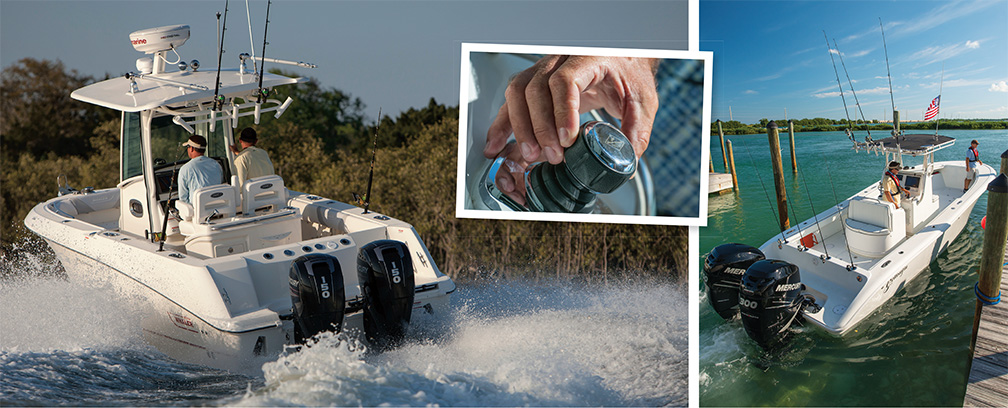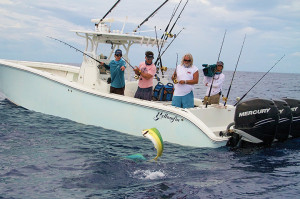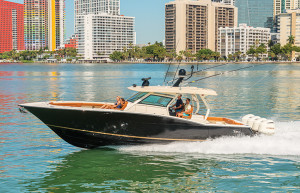Versatility, day boating trends lead to center console growth

While pontoon boats have commanded the lion’s share of the sales and market share headlines over the past several years, more recently some of the fastest and most impressive growth has occurred in the saltwater fishing segment.
The numbers don’t lie – according to the National Marine Manufacturers Association, wholesale shipments of saltwater fishing boats in 2014 were up an astounding 37.6 percent over the previous year, climbing to 7,985 units. Corresponding retail sales are said to have grown by a staggering 34.8 percent, to a healthy $2.3 billion. Further, the NMMA data notes that both wholesale and retail sales totals – measured in either volume or dollars – now eclipse pre-downturn levels from 2007, and are rapidly closing in on the all-time high-water mark of 10,940 units sold in 2005.
“The saltwater fishing segment has shown double-digit growth for the past three years, and I feel that’s largely due to the incredible innovation that’s been shown by the manufacturers,” notes NMMA president Thom Dammrich. “The product has evolved in order to align with the changing tastes of the buyers. Manufacturers have embraced the trend toward day-boating, and created more versatile boats with many more amenities than we used to see. They’ve successfully integrated a number of features that make the boats more appealing to families, while retaining that core ability to go out and fish seriously.”
At the core of this growth are center console boats, which represent a full 54 percent of all saltwater fishing boats sold, according to NMMA. The balance of the market is represented by “other fish” types (mainly dual consoles) representing 31.2 percent of the saltwater segment, followed by walkarounds representing 10.4 percent, respectively. Flybridge sedans, convertibles and 24-foot-plus “open express fish” types round out the market, collectively splitting the remaining 4.4 percent of the saltwater fishing category.
“Center consoles are absolutely driving the market, no question” said Huw Bower, president of Boston Whaler. “We’re very data-driven, we study the analytics closely. Any way we cut the data, it’s the center console that’s driving the activity. Walkarounds are also doing well, but it’s the new center consoles that are really leading the way.”
Bower attributes the growing demand for center consoles to shifts in boater behavior. Where boaters once placed a premium on sleeping accommodations, the emphasis today has moved to making space for fishing, water sports and other activities.
“The phenomenon of day-boating is now clearly entrenched,” said Bower. “We’re just not seeing people overnighting in their boats like they used to. And that lends itself to the center console market. Take a 40-foot center console and over the course of the day, you use every square inch of that boat. It’s such a versatile sport, cruising and fishing platform. You can sit out in the sun, or you can sit under the top and enjoy the shade, but still be outside in the fresh air. You have a head compartment so the whole family can be comfortable, plus all sorts of new features that mean you don’t have to give up having incredible comfort.”

So far, there’s no sign of the market slowing down. Whether it’s large center consoles, mid-sized walkarounds or smaller inshore boats, manufacturers are generally forecasting continued growth over the next 18 to 36 months.
“Our sales have increased by more than 20 percent compounding over the past three years,” said Alan Lang, national/international sales manager for Scout Boats. “It’s in our forecast to grow our revenues by another 20 percent for the 2016 calendar year, and through 2017 and 2018. We have a great deal of interest in our product line and a production backlog on our larger models, with little to no inventory in the field.”
With a growing economy, demand should continue for a while yet, said Joan Maxwell, president of Regulator Marine.
“Everyone who rode that economic roller coaster through the downturn seems to be feeling much more confidence today,” she said. “They’re cautious, for sure, but definitely more confident. In the past, new boaters would often get their feet wet by starting with a used boat, but that doesn’t seem to be the case now. For starters, there isn’t much late-model inventory out there, because through 2009, 2010 and 2011 we as an industry simply didn’t build a lot of boats. But beyond that, the product has evolved and in any case it’s the new boats with the new features that they want to buy.”
Size matters
Where a 40-foot center console might have once been a bit of an oddity, the number of them which have appeared on the market over the past 18 months or so underscores the growing trend toward larger and more powerful boats.

Although NMMA doesn’t specifically track boat sales by size, what is clear is that the average retail price of saltwater fishing boats has effectively doubled over the past 10 years, reflecting the trend toward larger hulls and multiple engines. According to the association’s data, the average retail price of a saltwater fishing rig in 2014 was a hefty $284,259. Just 10 years ago, that figure was $141,877. Where total retail sales for the saltwater fishing segment are estimated at $2.3 billion in 2014, the figure for 2004 is almost half that amount, at $1.2 billion.
“At Regulator we’re seeing particularly strong growth in the upper end of the product lineup,” Maxwell said. “So we’re moving forward to accommodate a growing demand for larger boats, which for us is 28 feet and up. We build a 41 that has been extremely well received. To accommodate that boat, and another new model we have planned, we are considering an expansion of our manufacturing facility. A 41-foot boat takes up a lot of space, but there’s also about 50 different large molds that are used to produce that model. With larger boats becoming increasingly popular we will need to put ourselves in the position to better meet that demand.”
Versatility rules
Of course, size alone isn’t everything. One big reason for the meteoric rise in center console sales figures lies in the fact that the newer models boast a number of features that make them far more versatile and family-friendly than their predecessors were.
“Although a customer buys a fishing boat, they don’t necessarily want to fish exclusively every single day,” said Tom Slikkers, CEO of S2 Yachts, manufacturer of the Pursuit and Tiara brands. “Some days they may not want to fish at all. They might want to paddle board, or take the boat out and go to a restaurant for a nice meal, or enjoy an evening cruise with a business associate. Today’s boats need to perform multiple roles. It used to be that you would say ‘I bought a ski boat’ or ‘I bought a fishing boat,’ the same way you would say you bought a sports car or a pickup truck or family sedan. That’s the way it was for years. But today, many people simply drive an SUV that does it all, and they expect the same multi-role capability from their boat. So you can look at a new center console and say yes, it’s still a center console, but today’s boat will have vastly greater capability and comfort reflecting its greater overall versatility.”
Those luxurious amenities may have been attractive upgrades just a few years ago, but today buyers consider them essential standard features.
“Larger center consoles with more luxurious amenities and cabins inside the consoles have sold extremely well for us,” notes Lang. “But the boat has to do more than just fish. You have to be able to entertain, and you have to be able to do that in comfort. Versatile, comfortable seating, a head compartment, a place to sit down and eat, now those are all expected.”
Outboard power

NMMA data from its 2014 abstract shows outboard motor shipments are up, and especially big four-strokes. Much of this increase can be attributed to the steady growth of the saltwater fishing segment. Of the $2.3 billion spent on saltwater fishing boats in 2014, outboard-powered boats represented a staggering $1.9 billion of that total.
More recent NMMA data released in November showed U.S. outboard engine shipments between November 2014 and October 2015 to be a full 4.9 percent higher than for the same period one year earlier. The picture is even rosier in Canada, where wholesale outboard shipments were reported to be up by 15.6 percent over the previous reporting period. Corresponding dollars were up by 21.9 percent. In its corresponding press release, NMMA noted that four-stroke outboards, and higher-horsepower models in particular, are driving the bulk of this growth.
“When the market began to rebound it was led by outboard power,” said Bower. “It started with aluminum fishing boats and pontoons, and now the saltwater segment is growing because of the consumer’s preference for outboard power. That’s driven by the availability of larger, more powerful engines with new technologies like joystick controls, that make docking so easy that anyone can do it.”
The growing market share of outboards within the saltwater fishing category has come at the expense of inboards and sterndrives, said Rob Parmentier, Marquis-Larson Boat Group president and CEO.
“I/Os have been down every month for 10 years in a row,” he said. “Technologically-speaking, outboard power has simply outpaced I/O. Both Mercury and Volvo Penta have both introduced great stuff, don’t get me wrong, but the innovations within the outboard industry have been tremendous. The new engines offer better performance, better power-to-weight, better fuel economy, there’s minimal winterization requirements so they’re more appealing to boaters in the northern part of the world, and you can tilt them right out of the water to keep marine growth off, which appeals particularly in saltwater. There’s really no downside. They don’t smoke and they’re quiet – you start up a new outboard and you can’t hear it. You get incredible performance and minimal maintenance. That’s what people want.”
Ripple effect
While the bulk of the saltwater fishing market continues to be concentrated in the Southeast, changes toward outboard power and more versatile, multi-role designs are having a ripple effect that is being felt across North America.

“We’ve seen growth accelerate in the Southeast faster than anywhere else,” Slikkers said. “But what we’re also seeing is the acceptance of larger outboard engines and the greater utility of the boats themselves opening up new opportunities in other regions, like the Northeast or the Midwest. Pursuit boats made in Florida for offshore ocean fishing are also appealing to buyers on the Great Lakes, for example. The category is growing because of technological developments and improvements to the product, it’s not tied to specific geography.”
It’s even crossing international borders.
“We didn’t used to sell many center consoles in Canada, but that’s starting to change,” Parmentier said. “People are using them as SUVs to go to their cottages, especially if their place is on an island and they need to transport a lot of stuff. A center console is great for hauling gear, and it’s comparatively low maintenance so buyers can spend more time enjoying their boat and less time cleaning it. Even our 20-foot center console has a full stand-up head, so it appeals to families and not just hard-core fishermen.”




